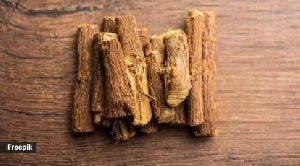One of the oldest herbal treatments in history, this component has numerous positive effects on the skin.

It contains liquiritin, an active ingredient that aids in removing extra melanin from the skin, which is what gives skin its color. This aids in balancing skin tone.
Due to its potent antioxidant and anti-inflammatory actions, it also provides wonderful skin benefits. (Refer to Freepik)
Licorice root, which is derived from the licorice plant's root and one of the world's oldest herbal treatments, is a native of Western Asia and Southern Europe. Licorice, which comes from the glycyrrhiza glabra plant, has long been appreciated in Japan for its therapeutic qualities and health advantages. It is a perennial plant with a sweet-tasting root that is widely known for containing a variety of bioactive natural compounds. According to Dr. Indur Ramchandani, Director Dermatology, Jaslok Hospital & Research Center, "Glycyrrhizin, the sweet component of licorice root, is a triterpene-type saponin that has antiviral, anti-inflammatory, anticancer, and antibacterial effects.
Here are a few advantages of licorice root that Dr. Ramchandani mentioned.
treats blemishes
Tyrosinase is inhibited by licorice root, which stops the growth of black patches on the skin. Additionally, it includes flavonoids, a type of plant polyphenol that acts as an antioxidant to prevent premature aging, environmental damage, and discoloration. This in turn aids in the management of melasma and hyperpigmentation.
Additionally, according to Dr. Ramchandani, licorice could heal acne by controlling the skin bacteria that cause acne. Licorice's anti-acne action controls the microbiological and metabolic balance.
Boosts skin radiance
It contains liquiritin, an active ingredient that aids in removing extra melanin from the skin, which is what gives skin its color. This aids in balancing skin tone.
SPF protection
A flavonoid, a plant polyphenol with antioxidant characteristics that can shield the skin from early aging, UV damage, and discolouration, is present in licorice root. Glabridin, which is known to help halt discoloration in its tracks during and right after exposure to the sun, is found in licorice, as Dr. Ramchandani pointed out. Skin discoloration is mostly brought on by UV rays, however glabridin contains UV-blocking enzymes that stop fresh skin damage from developing.
Licorice root aids in acne reduction. (Refer to Freepik)
inflammatory-reducing qualities
Licorice contains a molecule called glycyrrhizin, which has anti-inflammatory properties that lessen irritation, swelling, and redness. Additionally, it can be used to treat dermatitis.
skin that is supple
Collagen helps keep the skin supple and smooth by assisting in the renewal and repair of skin cells. The skin's collagen can be renewed with the aid of licorice root. Additionally, it increases the development of elastin, a naturally occurring protein that gives the skin strength and elasticity.
reduces irrational oil production
Excess sebum produced by skin glands causes oily skin, which then causes clogged pores and acne. Acne risk is decreased thanks to lico chalcone, a chemical found in licorice root that helps control oil production.
Licorice root is available as powder that can be taken orally, according to Dr. Ramchandani. Additionally, licorice root is an ingredient in many skincare products that can be applied topically 1-2 times per day.
The expert concluded by stating that "People with high blood pressure, heart, or kidney disease should avoid black licorice as well as those who have licorice allergies."
